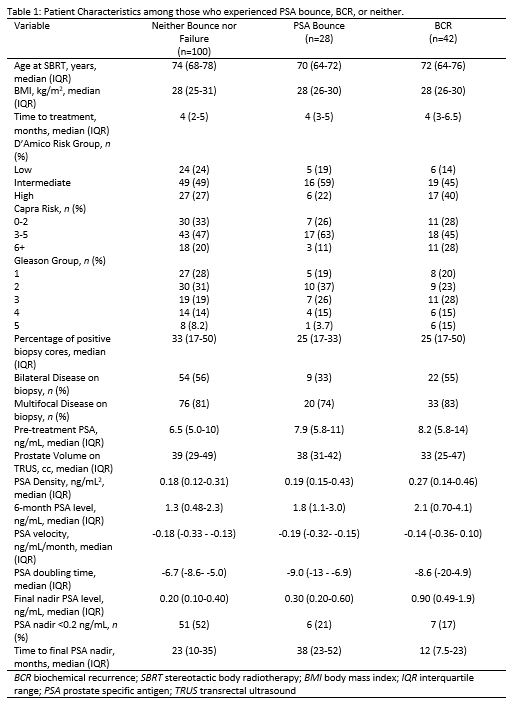Back
Poster, Podium & Video Sessions
Podium
PD22: Prostate Cancer: Localized: Radiation Therapy
PD22-09: Distinguishing Between Prostate Specific Antigen Bounce and Biochemical Recurrence Following Stereotactic Body Radiotherapy for Prostate Cancer
Saturday, May 14, 2022
10:50 AM – 11:00 AM
Location: Room 252
Ashley Monaco*, Glen Head, NY, Jessica Sommer, Garden City, NY, Jordan Mendelson, Jonathan Haas, Mineola, NY, Anthony Corcoran, Aaron Katz, Garden City, NY

Ashley Monaco, BS
New York Institute of Technology College of Osteopathic Medicine
Podium Presenter(s)
Introduction: While prostate specific antigen (PSA) bounce following radiation therapy for prostate cancer (PCa) treatment is well established, the parameters to predict this occurrence and differentiate it from biochemical recurrence (BCR) following stereotactic body radiotherapy (SBRT) are unknown. The purpose of this study is to investigate associations between pre-treatment and post-treatment variables among patients experiencing PSA bounce, BCR, or neither following SBRT.
Methods: An IRB-approved PCa database was reviewed for patients who underwent primary SBRT. Patients with less than 18 months of follow-up or were missing > 3 PSA measurements following SBRT were excluded. Patients were divided into outcome groups experiencing PSA bounce, BCR, or neither. PSA bounce was defined as a rise of >0.2 ng/mL over the pre-rise nadir followed by a decline without intervention. BCR was defined by Phoenix criteria. Pre-treatment and post-treatment characteristics were analyzed between groups. Results that were significant when comparing PSA bounce to BCR were then analyzed in a multivariate logistic regression model to determine predictors for PSA bounce.
Results: We analyzed 170 men with a median age of 72 (52-87) years with an average follow-up time of 75 + 21 months, of which 28 (16%) experienced PSA bounce and 42 (25%) had BCR (Table 1). Pre-treatment D’Amico and Capra risk, Gleason group, PSA, prostate volume, prostate density and post-treatment PSA velocity were not associated with PSA bounce when compared to BCR or non-BCR/bounce cohorts. Compared to those who did not experience PSA bounce/BCR, those with PSA bounce were younger (p <.05), had lower PSA doubling time (p <.001), and took longer to reach PSA nadir (p <.001). Compared to BCR group, men with PSA bounce had lower PSA nadir and took longer to reach nadir, both of which were significant predictors for PSA bounce (OR: 4.3, p<.05; OR: 0.90, p<.001). PSA bounce occurred significantly earlier than BCR (16 vs. 33 months; p<.001).
Conclusions: While there is overlap among patients who experience PSA bounce or BCR following SBRT, the timing of which the PSA rise occurs, the PSA nadir value, and the time to PSA nadir are useful variables in the management of a rising PSA in patients following SBRT.
Source of Funding: Department of Urology, NYU Langone Hospital – Long Island

Methods: An IRB-approved PCa database was reviewed for patients who underwent primary SBRT. Patients with less than 18 months of follow-up or were missing > 3 PSA measurements following SBRT were excluded. Patients were divided into outcome groups experiencing PSA bounce, BCR, or neither. PSA bounce was defined as a rise of >0.2 ng/mL over the pre-rise nadir followed by a decline without intervention. BCR was defined by Phoenix criteria. Pre-treatment and post-treatment characteristics were analyzed between groups. Results that were significant when comparing PSA bounce to BCR were then analyzed in a multivariate logistic regression model to determine predictors for PSA bounce.
Results: We analyzed 170 men with a median age of 72 (52-87) years with an average follow-up time of 75 + 21 months, of which 28 (16%) experienced PSA bounce and 42 (25%) had BCR (Table 1). Pre-treatment D’Amico and Capra risk, Gleason group, PSA, prostate volume, prostate density and post-treatment PSA velocity were not associated with PSA bounce when compared to BCR or non-BCR/bounce cohorts. Compared to those who did not experience PSA bounce/BCR, those with PSA bounce were younger (p <.05), had lower PSA doubling time (p <.001), and took longer to reach PSA nadir (p <.001). Compared to BCR group, men with PSA bounce had lower PSA nadir and took longer to reach nadir, both of which were significant predictors for PSA bounce (OR: 4.3, p<.05; OR: 0.90, p<.001). PSA bounce occurred significantly earlier than BCR (16 vs. 33 months; p<.001).
Conclusions: While there is overlap among patients who experience PSA bounce or BCR following SBRT, the timing of which the PSA rise occurs, the PSA nadir value, and the time to PSA nadir are useful variables in the management of a rising PSA in patients following SBRT.
Source of Funding: Department of Urology, NYU Langone Hospital – Long Island

.jpg)
.jpg)